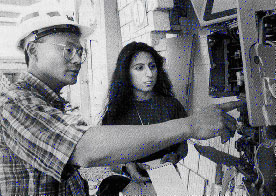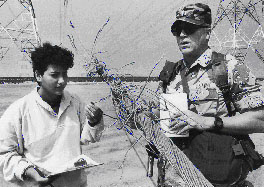 |
| Col. (later Brig. Gen.) Ralph V. Locurcio |
On 28 February 1991 a cease-fire ended military operations of the U.S.-led coalition in the Persian Gulf. In the immediate aftermath of the conflict, the mission for the U.S. Army Corps of Engineers rapidly evolved from one of support for military operations to one of emergency response. The goal was to return the crippled nation of Kuwait to its feet.
Even prior to the end of the war, the Kuwaiti government officially requested the Corps’ assistance following liberation. The Department of Defense (DoD) authorized the Corps to assist the Kuwaitis in restoring public works, electric, water, defense, and internal security systems. Colonel Ralph Locurcio, Savannah District Engineer, became the commander of the Kuwait Emergency Recovery Office (KERO), the organization that would fulfill the Corps’ mandated mission. KERO was set up along the lines of a Corps District, with separate offices for project management, emergency operations, engineering services, and contracting and support. On 28 January 1991 a KERO advance party arrived in Saudi Arabia and subsequently served as the lead agency for all civil restoration assistance provided by DoD. When it appeared that the war would end sooner than expected, KERO responded to a dramatically increased workload by employing a project management approach and swiftly executing needed contracting and logistics purchases.
 |
| A Corps employee, left, and Kuwaiti engineer inspect electrical damage at Ali Al-Salem. |
In the wake of the destruction resulting from the Gulf War, the Corps rose to the challenge by providing emergency aid to Kuwait. At the close of the ground war, KERO personnel and engineer elements attached to Task Force Freedom, the Army’s umbrella organizational unit for emergency operations, arrived in Kuwait City to render humanitarian assistance. KERO’s damage assessment teams were operating within 72 hours after the cessation of hostilities and eventually conducted more than 1,200 surveys. Combat engineers restored power for critical facilities such as hospitals, telecommunications centers, distribution warehouses, and financial institutions. KERO’s electrical crews restored primary power throughout the capital by March 23. Corps-hired contractors eventually repaired 10,000 kilometers of transmission lines and 29 electrical stations.
KERO also supervised the repair of breaks in the city’s main water supply line as well as sewage treatment facilities. Furthermore, KERO worked to quickly reopen the major gateways to Kuwait, namely the air and water ports. The most significant challenge was the rebuilding and repair of Kuwait’s road network. Bombing had obliterated major portions of the roadways; still other sections were littered with bomb craters or Iraqi bunker emplacements. KERO and its contractors filled in hundreds of bomb craters, removed 3,700 barriers emplaced by Iraqi troops, and repaired 200 kilometers of road.
 |
|
 |
| Contractors repairing the many bomb-damaged roads in Kuwait. |
|
An engineer captain, right, and Kuwaiti volounteer assess damage to power lines. |
Further reading:
Supporting the Troops - The U.S. Army Corps of Engineers in the Persian Gulf War, Janet A. McDonnell. October 1996. EP 870-1-50.
After Desert Storm -- the U.S. Army and the Reconstruction of Kuwait, Janet A. McDonnell. June 1999. EP 870-1-58.
* * *
January 2002